Floyd Bennett Field, Brooklyn. 1943.
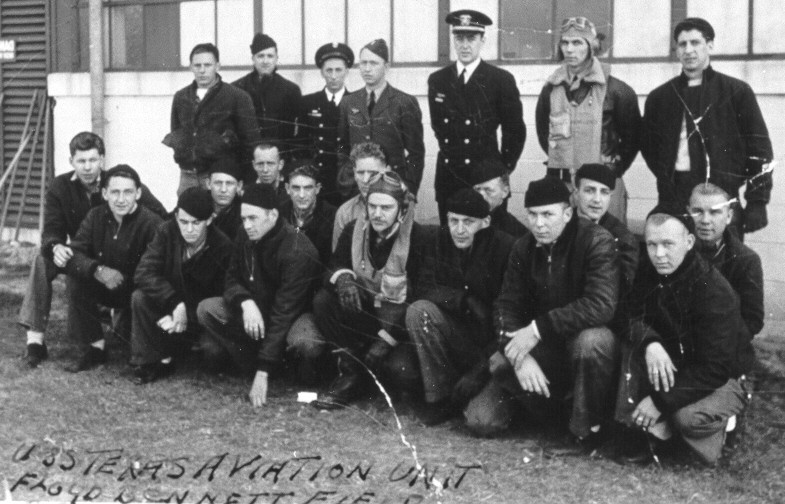
.
.
| Aviation: 1918 thru 1945 |
|
TEXAS aviation unit
Floyd Bennett Field, Brooklyn. 1943. |
 |
| Sources |
| Started with some accurately dated BB35 photos
which were compared with ship's photos containing airplanes and then correlated
with limited paper documents such as deck log, drawings and US Navy base
periods. Two sources from William T Larkins: *** His research into the history of many of the individual airplanes that were aboard TEXAS *** "Battleship & Cruiser Aircraft of the US Navy, 1910 to 1941"; William T. Larkins; Schiffer Military History, 1996. The book contains "Fleet Aircraft Assignment" showing what airplanes were assigned as of a particular month. Both Mr. Larkins sources identify the dates the airplanes were assigned to and reassigned from BB35 but not the date when the aircraft were brought aboard and removed. Some "Fleet Aircraft Assignment" tables only identify the airplanes assigned the battleship divisions and not to the specific ships in the division. |
| Overview |
| 1912 - first reference to aviation aboard BB35.:
The 1912 joiner drawing for 3rd deck shows compartment A-101 (near the bow) as the "Aviation Room" but no details |
|
| Periods | Aboard |
| Kite Balloon: 28 May 1918 to nlt
October 1918 Turret Platform: 4 November 1918 to nlt 10 August 1922 Main deck (stern): August 1923 to July 1925 Catapult: 3 November 1926 to 12 December 1945 |
1: Kite Balloon 10: Airplanes 2: Drones |
| Period 1 of 4: Kit Balloon - 28 May 1918 to nlt October 1918 |
The balloon was a two-man observation platform that floated 800 - 1000 feet above the ship, at the stern. A telephone was connected from the balloon to the bridge. Each occupant was provided a parachute. TEXAS was not the only US battleship in the 6th Battle Squadron to tow the balloon. I do not know when use of the balloon ended.. The object on the 14inch gun barrel is a bore site gun which fired a powder charge and was used during gunnery training. 28 May 1918: A kite balloon was brought aboard, from the kite balloon station, at Rosyth Scotland, from the book "North Sea Days" 11 June 1918: The kite balloon broke loose was an entry in the deck log Both photos from the TEXAS book "North Sea Days" |
|
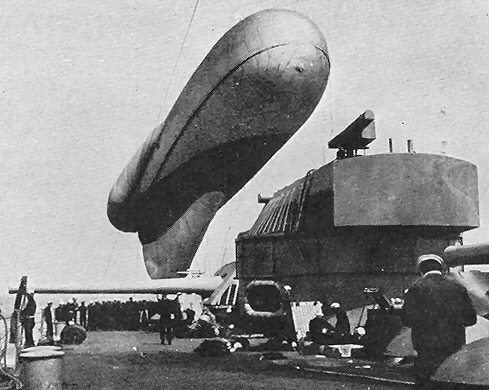  |
|
| Period 2 of 4: Turret Platform - 4 November 1918 to nlt 10 August 1922 |
| Aircraft launches were very infrequent, occurred near a US Navy facility where the landing took place. Pilots at this time were not part of ship's crew and only aboard when a launch was to occur. During this period, it is unknown if an airplane was continuously aboard. |
| Two Platforms Installed |
| Turret 2: 20 October - 4 November 1918:
In a British Royal Navy floating dry-dock,
at Jarrow Slake, England. (Jarrow is just east of Newcastle) The platform
installation is listed in the BB35 deck log. The distance from the tires to the
end of the wooden platform is 44 feet. Turret 4: 4 - 31 January 1919: In the New York Navy Yard. The date is based on a photo of TEXAS, in New York City, with a Sopwith Camel on a platform atop Turret 4. The photo has a caption referencing the March 1919 airplane flight, in Cuba. This leaves only the January 1919 period in the New York Navy Yard. Platform image: Leeward Publications, Ship's Data 6 , USS TEXAS (BB35) |
||
 |
| Two Airplanes |
|
1st of 10 Sopwith Camel
13 December 1918 to not later than 19 June 1919 |
|
.
Quantity:: 1 - 2.
Airplane Id number: None are available. Based on ship photographs, three were brought back from Europe, in December 1918. It is unknown if any Camel was continuously aboard until replaced by the Hanriot. The latest BB35 photo with a Camel aboard that I have seen is 14 April to 2 May 1919 with a Camel atop Turret 4, in the North River, in New York City. The airplane is not aboard in ship photos crossing the Panama Canal. |
| Photo from BB35 book "North Sea Days" |
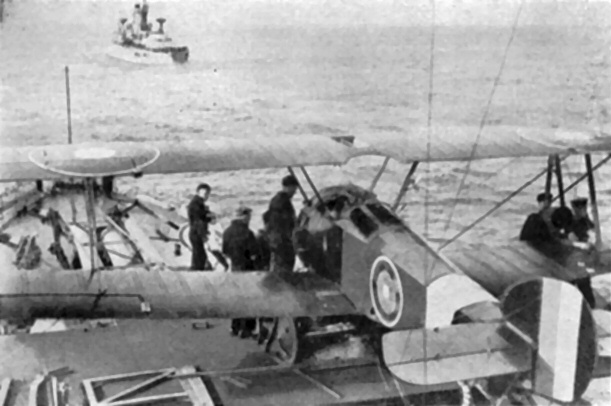 |
| 2 of 10 Hanriot HD2 | ||
| By 14 July 1919 and at least through 18 September 1919.
Quantity: 1. Airplane Id number: A-5621. Based on deduction and elimination the airplane was brought aboard during the New York Navy Yard period of 19 June to 14 July 1919. Only one airplane, the HD2, was aboard when TEXAS crossed the Panama Canal, 25 July 1919. A 12 September 1919 photo shows the HD2 atop Turret 2, as TEXAS enters Seattle, WA. On 18 September, BB35 enters the Bremerton Navy Yard, which was the first of three possibilities for removal. |
 |
||
| Possibly aboard |
| Sopwith 1 1/2 Strutter A ship photo shows what might be a partially disassembled strutter atop Turret 3, per Andy Kemp, of "Cross and Cockade". The photo was taken after BB35 left Brest, France 14 December 1918 with three airplanes aboard |
| Not Aboard |
| Vought VE-7H Though listed in the 1976 Leeward Publication TEXAS data book, I have not found any evidence of this plane having been aboard TEXAS Nieuport 28 Leeward Publication, page 38, a Hanriot incorrectly identified as a Nieuport. Mr Larkin's research has Nieuport A-5801 at NAS San Diego to be assigned to TEXAS, as of 28 April 1920. His notation continues with the airplane appears not to have been assigned and the airplane being scrapped as of 8 August 1921. TEXAS did not arrive at San Diego until 16 April 1922 with a previous departure of 9 August 1919. |
|
19 March 1919 First Fly-off From An American Battleship |
||
|
9 March 1919:
A single Sopwith Camel is brought aboard, from Conde Bluff Camp, Guantanamo Bay area, Cuba, and placed atop Turret 2 - BB35 Deck Log. 10 March 1919: Shortly after 4:45pm, Lt. Commander Edward O. McDonnell (Naval Aviator 18) a Sopwith Camel off of the platform atop Turret 2, in Guantanamo Bay, Cuba. Only one flight was made this day. The ship was stationary at the time of the flight 11 March 1919 At 9:30am, one Camel was brought back aboard and placed atop Turret 2. At 3:30pm the airplane flew off of the platform. Only one flight was made this day. |
||
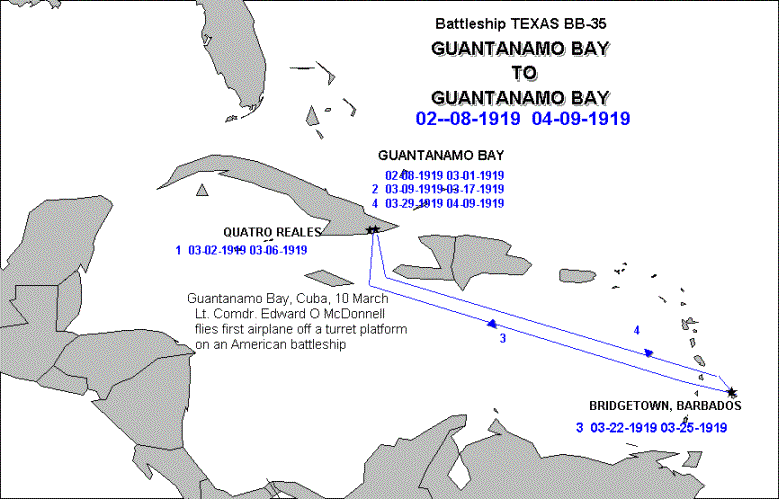 |
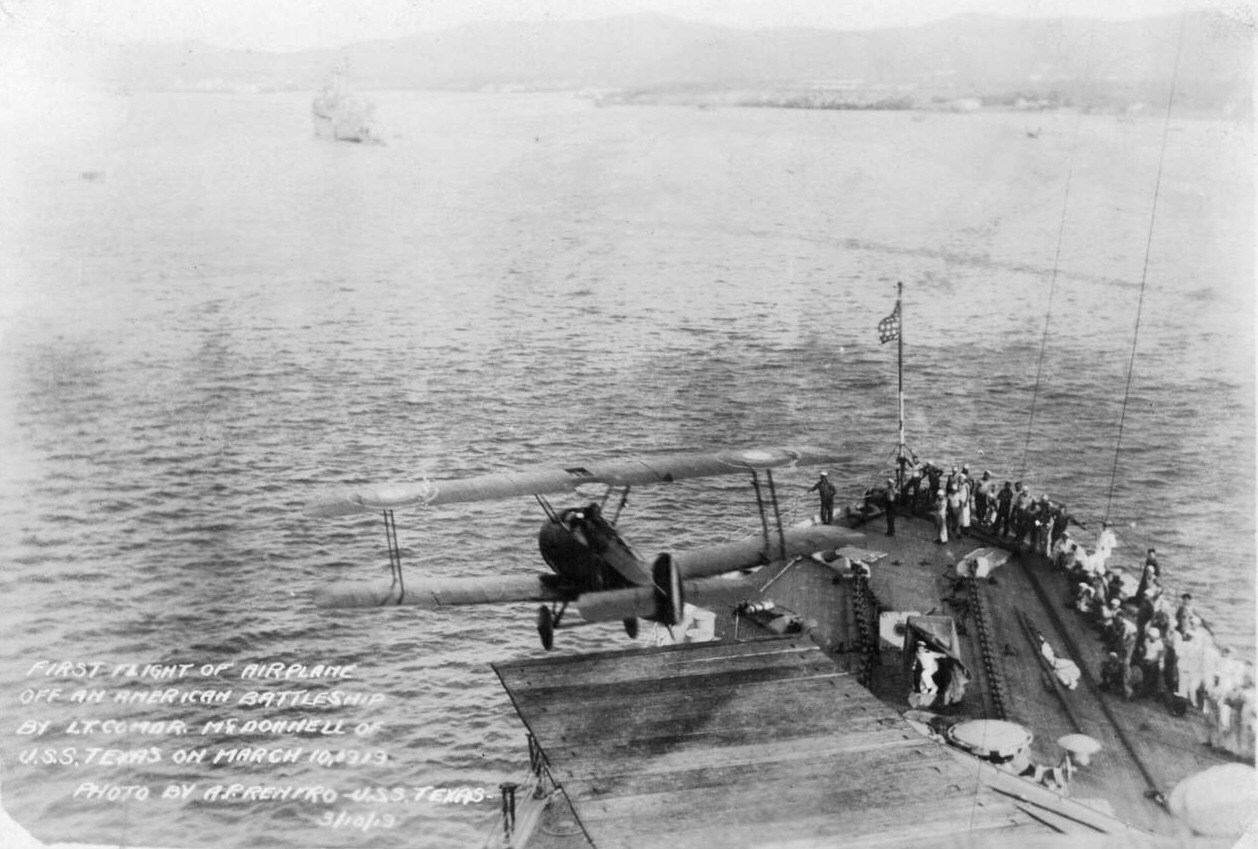 |
| Removed |
| Airplanes Not later than 12 August 1920, based on US Battleship OKLAHOMA having the last recorded platform launching on this date. Platforms Turret 4: NLT August 1921 NLT August 1921 when two 3inch guns were placed atop the turret. Photos still show the platform atop turret 2 after removal from turret 4. Turret 2: January - August 1922 A 1922 photo in Seattle, the platform is not present. Two Bremerton Navy Yard periods for removal, 3 January to 18 February 1922 or 7 to 10 August 1922. |
| Period 3 of 4: Main Deck - Fall 1923 thru July 1925 |
|
UO-1 (3rd of 10) |
| Date brought aboard is uncertain. July 1923 drawings show UO-1 on main
deck-stern yet the first reference to the airplane assigned to BB35 is 5 June
1924, A-6615, via Mr Larkins. |
| A single UO-1 as kept on the main
deck at the stern. Airplane take-off was done by lowering it into the water with
a starboard side crane and the plane then taking off with it's own engine power.
Recovery was done with the same boom to bring the airplane back aboard. The same plane would be brought back aboard after the July 1925 - November 1926 modernization but flown off the catapult. The catapult was designed to launch a 6,500 lbs airplane but the UO-1 weighed 2,600 lbs. Mr Larkins research and a 20 October 1928 issue of the ship's weekly newspaper both reference the plane being aboard after leaving the modernization dry-dock. The airplane was reassigned on 1 July 1927, per Mr Larkins. |
| Airplane is NEW YORK |
 |
 |

| Period 4 of 4: Catapult - 26 November 1926 - 12 December 1945 |
| Catapult - P-4 Mod 1 w Mark III Powder Gun |
| Catapult always powered by a powder charge. |
| Eight airplanes and two types of drones |
| Per C&R drawing #
131538, dated 1926, the catapult was designed to launch a 6,500pound airplane at
55mph. Catapult image: Leeward Publications, Ship's Data 6 , USS TEXAS (BB35), 1976 |
| Plane UO-1 OL-6 O2U O3U SOC OS2U |
Pounds 2,600 5,500 3,635 4,451 5,437 6,000 |
 |
| Catapult Activity - World War II |
| 22 May 1944 The catapult and airplanes removed in Belfast, Northern Ireland in preparation for the invasion of Normandy 7 July 1944 The catapult and airplanes brought back aboard with the catapult being lashed to deck, in Belfast, N. Ireland 25 July 1944 Catapult installed atop Turret 3, Oran, Algeria but the airplanes were removed (Oran or Taranto, Italy), in preparation for the invasion of Southern France. 18 August 1944 Airplanes and aircrews were brought back aboard, Palermo, Sicily September 1944 US Navy considered modifying the P-4 mod 1 catapult to accommodate the SC-1(replace OS2U). Examination continued through July 1945. July 1945 Navy Bureau of Aeronautics initiated action to modify the cruiser P6 catapult into P6-2 catapults for ARKANSAS, NEW YORK and TEXAS. 12 December 1945 - Catapult permanently removed Terminal Island Dry Dock, near Los Angeles. The planes are in a ship's photo 27 October 1945 commemoration of US Navy Day, in Los Angeles. |
|
Airplanes Aboard (3 - 10) |
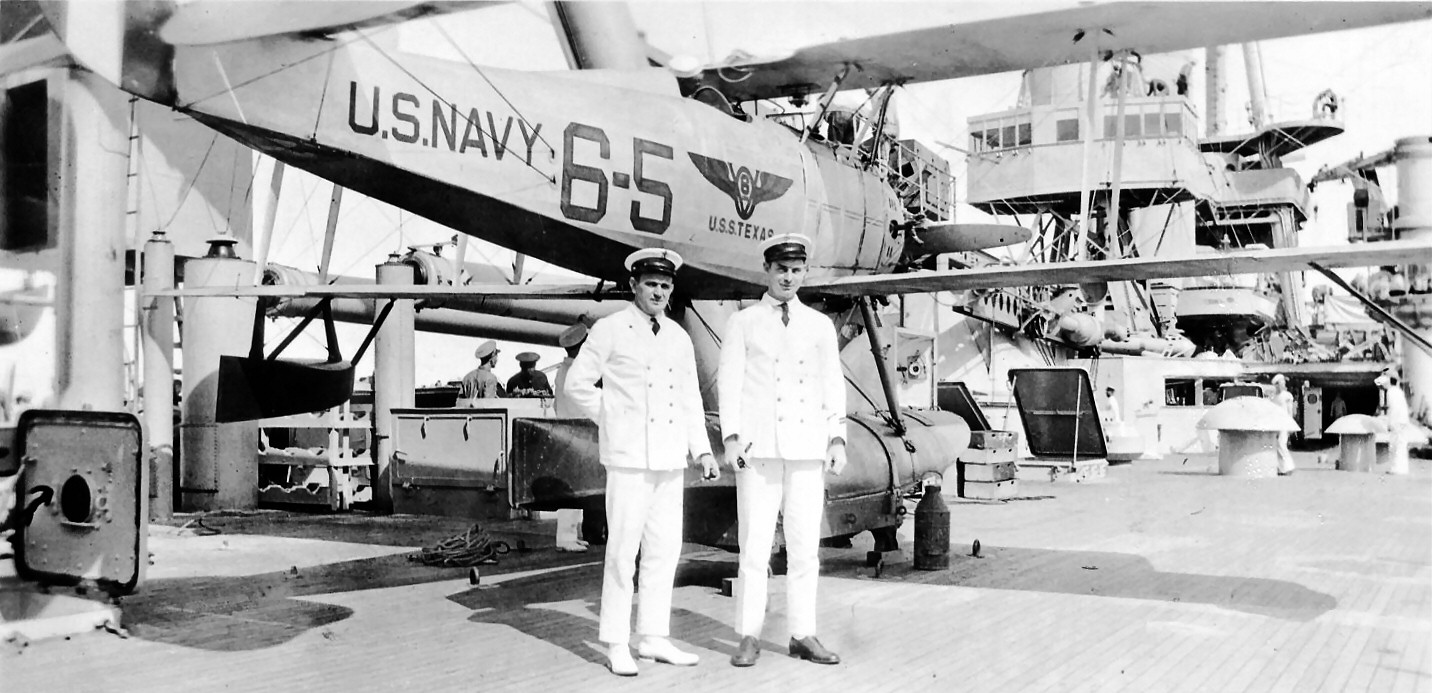 |
#3 UO-1 by Vought |
11 November 1926 to 3 July 1928 In the photo, the officer has
white shoes and the enlisted man is wearing brown shoes. The October 1928 issue
of the ship's weekly newspaper states a catapult launch of the UO-1 was quite a
jolt for the 2,600 lbs airplane was launched by a catapult designed to launch a
6,500 lbs airplane. The UO-1 first came aboard in the fall of 1923 and operated
at the stern of main deck. To launch the airplane a boom picked it up and
lowered it into the water for take-off by the planes own power |
||
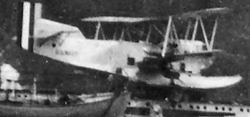 |
#4 OL-6 by Loeing |
1 January 1927 to 27 June 1928 The 20 October 1928 ship's
newspaper refereed to the airplane as "the duck" and did not have anything
positive to say about the airplane. Leaked oil badly |
||
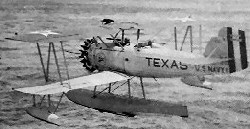 |
#5 O2U-1 by Vought |
28 June 1928 to June 1930: (brought aboard in October) The 20 Oct 1928 ship's newspaper has an article about the new O2U being aboard. |
||
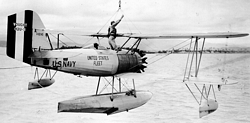 |
#6 O2U-3 by Vought |
June 1930 to June 1931 The airplane for the CinC US Navy, which is designated by the fuselage marking "United States Fleet". | ||
 |
#7 O3U-1 by Vought |
June 1931 to October 1932 October 1932 to June 1933 ??? - see O2U-3 above June 1933 to August 1933 18 December 1934 to June 1936 |
||
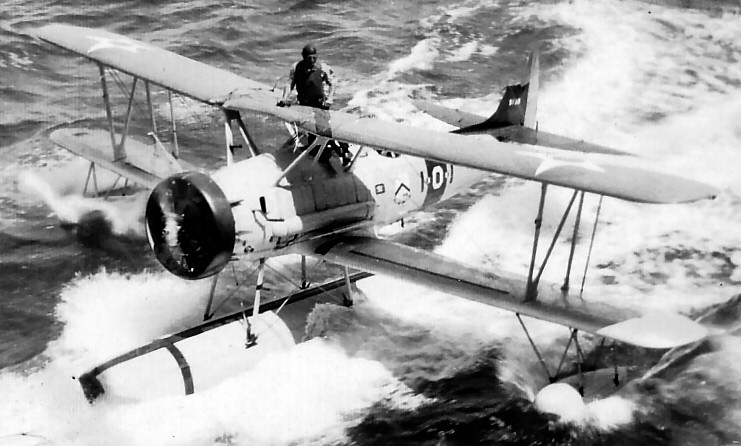 |
#8 O3U-3 by Vought |
On the fuselage, the number aft of the stripe denotes the battleship division and the forward number is the aircraft's division identification number, meaning this airplane is #1 in Battleship Division One. The airplanes were removed in the summer or 1937 when TEXAS was assigned to the Training Squadron. | ||
 |
#9 SOC-3 by Curtis |
16 October 1939 to 29 April 1941 The SOC-3 is aboard in a 2 Feb 1940 photo of TEXAS entering Havana. The identify of the SOC-3 left is #1 in Battleship Division 5. | ||
 |
#10 OS2-U by Vought- Sikorsky |
1941 (prior to August) to not later than 12 December 1945, when
the catapult is removed. During the November 1942 invasion of North Africa, one airplane sank and another bombed enemy tanks. After the invasion, Walter Chronkite flew off TEXAS in an OS2-U when the ship was within range of Norfolk. At the start of 1943 three were still aboard but reduced to two before 1944. During the invasion of Normandy, the airplanes were removed. During the invasion of Okinawa, #8 sank during recovery due to damage from anti-aircraft fire and #7 strafed small Japanese boats. |
||
| DRONES |
| .Drone Launches (BB35 War Diary) 3 - 5 January 1945: Hawaii 7 - 9 August 1945: San Pedro Bay, Philippines |
 |
.
Started 11 May 1999 Chuck Moore, FTV (1st Texas Volunteers) BB35 volunteer group